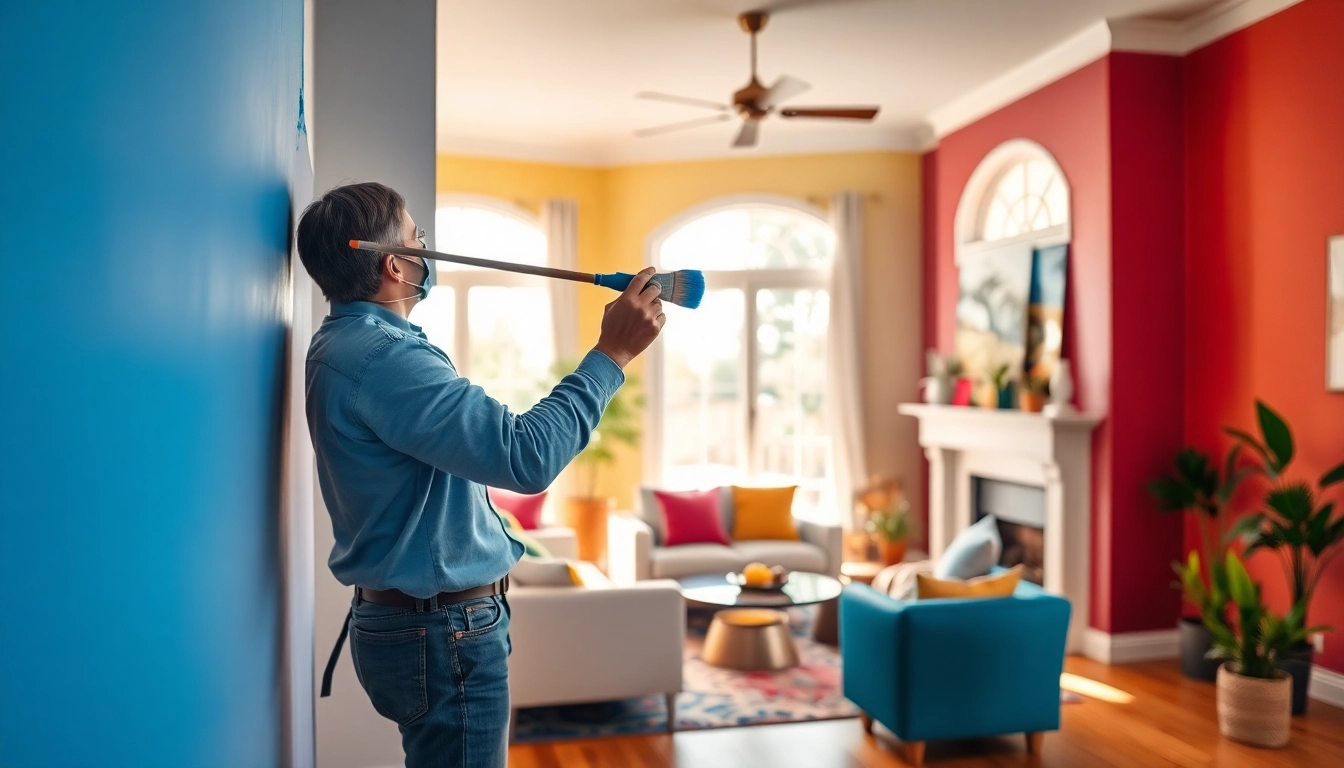Understanding Interior Painting Basics
Interior painting is more than just color choice and brush strokes; it’s an opportunity to express your personality and to improve the aesthetic value of your home. Understanding the fundamentals of painting interiors will help you achieve stunning results while extending the lifespan of your painted surfaces. In this article, we will delve deep into various aspects of interior painting, from the materials used to the techniques employed.
The Importance of Quality Materials
Using high-quality materials for interior painting can significantly influence the durability and finish of your project. Paint selections often fall into categories such as latex, oil-based, or acrylic, each having distinct characteristics that suit different surfaces and environments.
- Latex Paint: Water-based and easy to clean up, this type of paint is climate-friendly, dries quickly, and provides a flexible finish, making it suitable for most interior applications.
- Oil-Based Paint: Best for areas requiring durability like trim and moldings, oil-based paints offer a high-gloss finish that is less prone to wear but necessitates solvent cleanup.
- Acrylic Paint: This versatile paint can be used on both interiors and exteriors, offering excellent adherence and durability.
Choosing the Right Tools for Your Project
The right tools not only make the painting process smoother but also enhance the quality of the finish. Essential tools include:
- Brushes: Use high-quality brushes for cutting in edges and achieving fine detail work. Synthetic brushes are preferred for latex paints, while natural bristle brushes work better with oil-based paints.
- Rollers: For large areas, rollers can help speed up the process. Select the nap thickness based on the texture of the surface being painted.
- Drop Cloths: Always protect your floors and furniture. Canvas drop cloths are reusable and more durable than plastic sheets, which can shift easily.
- Painter’s Tape: Essential for achieving clean lines; it prevents paint from seeping onto surfaces you wish to keep clean.
Key Techniques in Interior Painting
Mastering a few painting techniques can drastically improve your results:
- Cutting In: This technique involves using a brush to paint around trim, corners, and ceilings before using a roller on the larger surfaces.
- Feathering: When blending colors or applying a second coat, feather the edges to create a seamless transition.
- Rolling: Use a steady, even pressure to avoid streaks when rolling on the paint, and change directions frequently to achieve an even finish.
Planning Your Interior Painting Project
Successful interior painting begins with thorough planning. Understanding the scope of your project will save you time, money, and frustration.
Setting a Budget for Interior Painting
To establish a realistic budget for your project, consider the following:
- Materials: Estimate how much paint and supplies you’ll need based on the number of rooms and their sizes. Research paint costs, and also account for tools that may need to be purchased or rented.
- Labor: If you’re hiring professionals, obtain multiple quotes to gauge the going rates in your area. Ensure that estimates include all necessary services, such as surface preparation and cleanup.
- Unexpected Expenses: Set aside an additional 10-20% for unexpected costs that may arise, such as repair work on damaged walls or ceilings.
Creating a Color Palette
Color choice is a crucial element of any painting project. To create a cohesive palette:
- Consider Light: Paint colors can look vastly different based on lighting. Test swatches in different light conditions.
- Choose a Focal Point: Identify a room element to draw attention to, and select colors that complement it.
- Limit Your Palette: Stick to a maximum of three colors to avoid overwhelming the space.
Measuring and Preparing Your Space
Before you start painting, proper preparation can determine the final result:
- Measure Wall Areas: Calculate the square footage of each wall to accurately estimate how much paint you will need.
- Repair Surfaces: Fill cracks, holes, and imperfections with appropriate fillers to create a smooth surface.
- Clean Walls: Dust and wipe down surfaces to ensure proper adhesion of the paint.
- Masking: Use painter’s tape to protect surfaces you don’t want painted.
Executing Interior Painting Like a Pro
Once planning and preparation are complete, it’s time to put your knowledge into action!
Step-by-Step Painting Process
Follow this structured approach to achieve a professional-looking finish:
- Prep the Room: Remove or cover furniture, tape edges, and lay down drop cloths.
- Cut In: Start with a brush to paint edges and corners.
- Roll on Paint: Work in large sections, blending each new section into the previous one before it dries.
- Apply Additional Coats: Depending on the color and finish, a second or third coat may be necessary for solid coverage.
- Finish Trim: Once the walls are dry, paint the trim and baseboards.
- Cleanup: Properly clean brushes and dispose of materials responsibly.
Common Mistakes and How to Avoid Them
Even experienced painters can make mistakes. Here are common pitfalls and tips to avoid them:
- Skipping Primer: Always use a primer, especially with lighter colors over darker surfaces; it improves coverage and finish.
- Rushing the Job: Take your time, especially when applying coats. Allow adequate drying time to avoid peeling and cracking.
- Ignoring Temperature and Humidity: Ideal conditions are between 50 to 85 degrees Fahrenheit, with moderate humidity.
Ensuring a Smooth Finish
A smooth finish often depends on attention to detail:
- Sand Surfaces: Lightly sanding between coats can help achieve a better finish.
- Use High-Quality Paints: They typically provide smoother finishes and better coverage.
- Maintain Consistent Technique: Use steady pressure while rolling and brush in the same direction for uniformity.
Post-Painting Care and Maintenance
After the paint has dried and the project is complete, proper maintenance can ensure that your hard work lasts.
How to Clean and Maintain Painted Surfaces
Regular cleaning can help maintain your painted surfaces:
- Dust Regularly: Use a microfiber cloth to dust surfaces to prevent dulling of paint.
- Spot Clean: For stains, use a gentle cleaner appropriate for the paint type. Avoid harsh chemicals.
- Touch Up If Needed: Keep leftover paint for touch-ups in case of scratches or dents.
Touch-Ups and Repairs for Longevity
Performing touch-ups can prolong the life of your paint job:
- Identify Problem Areas: Regularly inspect walls and trims for damage or wear.
- Match the Paint: If you don’t have the original paint, try taking a paint chip to a professional store for matching.
- Reapply if Necessary: Don’t hesitate to repaint small areas that look worn.
Seasonal Considerations for Interior Painting
Different seasons can impact your painting plans:
- Winter Time: It’s best to avoid painting in humid conditions; utilize dehumidifiers to facilitate drying.
- Summer Painting: Ensure it’s cool enough so the paint doesn’t dry too quickly, leading to streaks.
- Fall Maintenance: Touch up any areas before winter to prevent moisture damage.
Hiring Professional Painters
While many homeowners choose to paint their interiors themselves, hiring professional painters can save time and yield expert results.
When to Hire Professionals for Interior Painting
Consider hiring professionals when:
- Scaling Projects: When dealing with extensive renovations or multiple rooms.
- Safety Concerns: Complex or high areas that require ladders or scaffolding.
- Lack of Time or Skills: Sometimes time constraints or the intricacies of job details determine the need for professionals.
Questions to Ask Your Painter
Before hiring a painter, consider asking the following:
- What is your experience level with similar projects?
- Can you provide references or examples of past work?
- What financing options are available?
- What guarantees or warranties do you offer for workmanship?
- How do you handle unexpected complications or costs?
Understanding Estimates and Contracts
Finally, make sure you receive a detailed estimate that outlines what is included in the price:
- Scope of Work: The estimate should clearly describe what tasks will be performed.
- Materials: Make sure the type of paint and brand is indicated.
- Payment Schedule: Understand when payments are due and clarify deposit amounts.
- Completion Timeline: Ensure you have a clear timeline for the project.
By following these guidelines and insights into interior painting, you can navigate the process from planning through execution to maintenance with confidence. Whether you choose to tackle the project yourself or hire professionals, a well-executed painting job can dramatically enhance the ambiance and value of your home.



